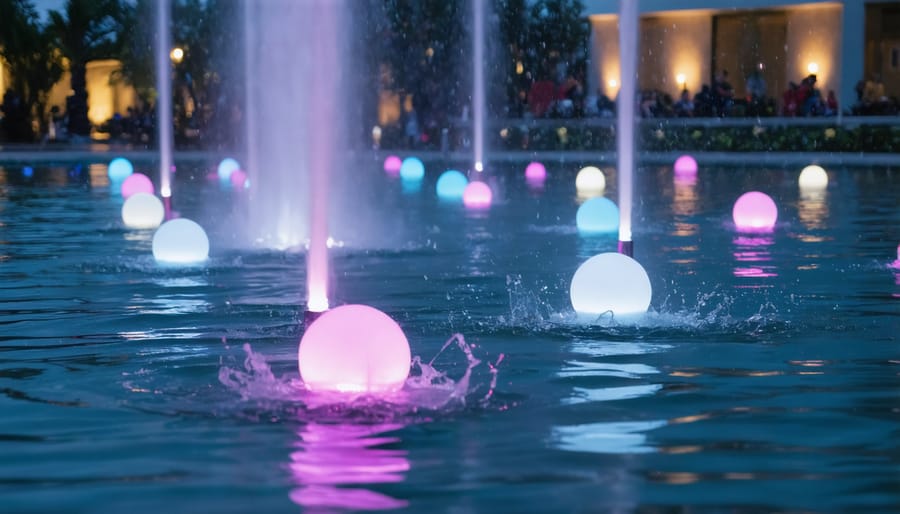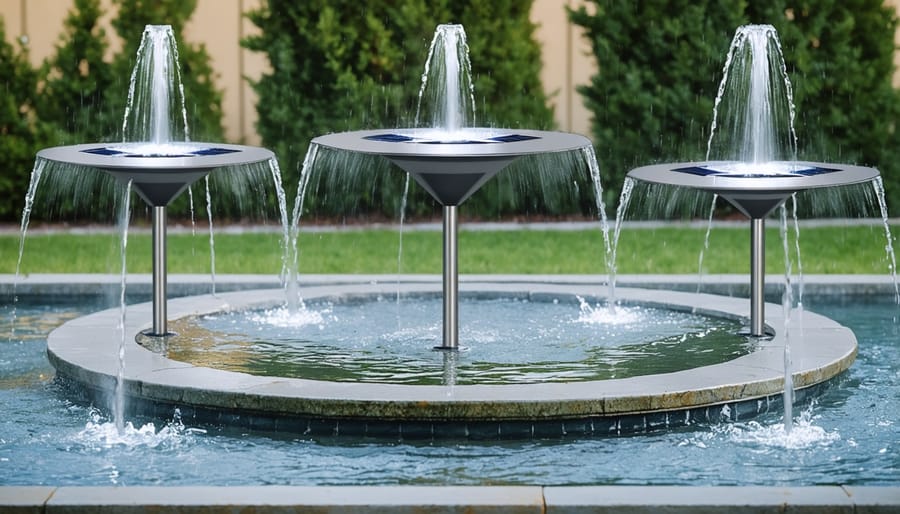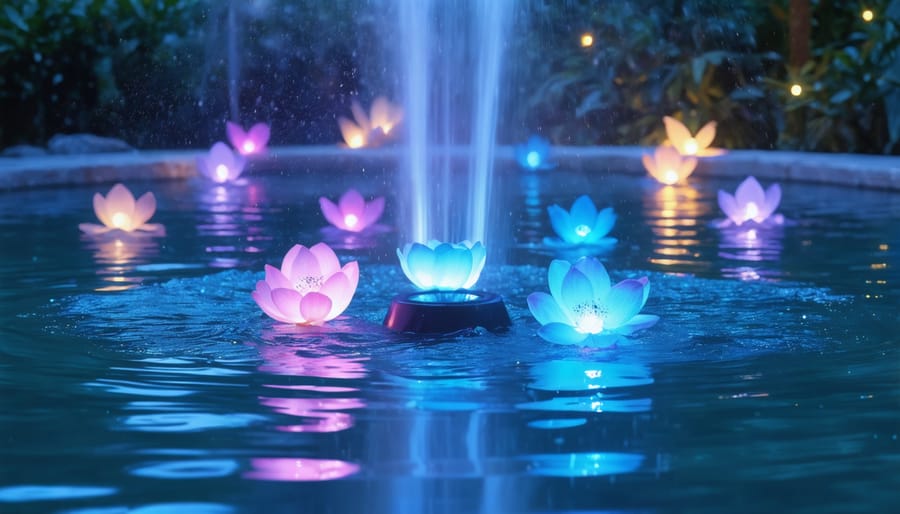Transform Your Fountain into a Magical Night Display with Solar Lights
Transform your fountain into a mesmerizing nighttime display with floating solar lights that harness the sun’s energy to create enchanting water features after dark. These innovative lights combine sustainable technology with aesthetic appeal, offering an eco-friendly solution to outdoor lighting that requires zero electricity costs or complex wiring.
Floating solar lights work by collecting solar energy during daylight hours through small panels, storing it in built-in batteries, and automatically illuminating when darkness falls. The result is a self-sustaining light show that dances across your fountain’s surface, creating stunning reflections and adding depth to your outdoor space.
Beyond their visual appeal, these solar-powered fountain lights represent a smart investment in sustainable outdoor decoration. They’re incredibly easy to install – simply place them on the water’s surface and let nature do the rest. Whether you’re looking to enhance a small garden fountain or illuminate a large water feature, floating solar lights offer a practical, energy-efficient solution that brings your outdoor space to life after sunset.
How Solar Fountain Lights Work
Solar Panel Efficiency
Modern floating solar lights are equipped with highly efficient photovoltaic cells that convert sunlight into electricity throughout the day. These cells are specially designed to work even in partial shade or cloudy conditions, making them reliable for year-round use. Most models feature monocrystalline or polycrystalline silicon panels that can capture both direct and indirect sunlight.
The collected energy is stored in built-in rechargeable batteries, typically lithium-ion or NiMH, which provide power for 8-12 hours of illumination after dark. Premium models often include smart charging technology that prevents overcharging and extends battery life. Some advanced units even incorporate automatic brightness adjustment features that conserve energy on cloudy days to ensure consistent lighting performance.
For optimal solar collection, the panels should face direct sunlight during peak hours. Many floating lights automatically rotate to track the sun’s position, maximizing their energy absorption potential throughout the day.

LED Technology and Water Resistance
Modern floating solar lights utilize energy-efficient LED bulbs that provide bright, clear illumination while consuming minimal power. These LEDs typically last 50,000 hours or more, making them a reliable choice for long-term outdoor lighting. They come in various color options, from warm white to vibrant RGB, allowing you to create different moods for your fountain display.
The waterproofing technology in these lights is equally impressive. Most quality fountain lights feature an IP68 rating, meaning they’re completely protected against dust and can be continuously submerged in water. The solar panels and LED housing are sealed with durable silicone or rubber gaskets, preventing water from reaching sensitive components.
Many models include additional protective features like UV-resistant materials that prevent yellowing and deterioration from sun exposure. This combination of advanced LED technology and robust waterproofing ensures your fountain lights remain bright and functional through all seasons, requiring minimal maintenance while delivering optimal performance.

Choosing the Right Solar Fountain Lights
Size and Power Considerations
When selecting floating solar lights for your fountain, size matching is crucial for both aesthetic appeal and optimal performance. For small decorative fountains under 3 feet in diameter, compact lights measuring 3-4 inches work best. Medium-sized fountains between 3-6 feet benefit from 5-7 inch lights, while larger fountains over 6 feet may require multiple lights or larger 8-10 inch units.
Light brightness should correspond to your fountain’s size and desired effect. Small fountains typically need 10-20 lumens per light, while larger installations might require 30-50 lumens or more. Consider that brighter isn’t always better – gentle illumination often creates more enchanting effects than intense lighting.
For power requirements, look for solar panels rated between 1-2 watts for small fountains and 2-4 watts for larger ones. The panel size should be proportional to the light output you need. Remember that darker surroundings require less powerful lighting, while areas with ambient light may need brighter options to create the desired impact.
Choose lights with adjustable floating angles to highlight specific fountain features and achieve the perfect illumination pattern for your water feature.
Style and Color Options
Floating solar lights for fountains come in an array of enchanting designs to suit any outdoor aesthetic. From classic spherical orbs that create gentle, diffused illumination to modern geometric shapes that add contemporary flair, these lights serve as both functional and decorative elements. Many models offer creative outdoor lighting solutions with color-changing capabilities, allowing you to switch between soothing white light and vibrant RGB hues.
Popular styles include lotus flowers that bloom on the water’s surface, minimalist disc designs that seem to float invisibly during the day, and natural-looking rock formations that blend seamlessly with landscape features. Some models feature cascading light patterns that create mesmerizing ripple effects on the water, while others maintain a steady, warm glow perfect for ambient lighting.
Most designs incorporate weatherproof materials in neutral tones like bronze, silver, or stone-like finishes, ensuring they complement existing fountain features. For those seeking more dramatic effects, some models include programmable light sequences and remote control options, allowing you to customize your fountain’s appearance for different occasions or seasons.
Installation and Maintenance Tips
Proper Placement for Maximum Solar Exposure
To maximize your floating solar lights’ performance, positioning is crucial. Place your lights where they’ll receive direct sunlight for at least 6-8 hours daily. The charging panels should face south in the Northern Hemisphere (or north if you’re in the Southern Hemisphere) to capture the most sunlight throughout the day.
Avoid areas where trees, buildings, or other structures cast shadows on your fountain during peak sunlight hours. If your fountain is near tall objects, consider tracking the shadow patterns throughout the day to find the optimal spot for your lights.
For fountains with multiple tiers, position the lights so they’re not constantly splashed by falling water, which could reduce solar panel efficiency. Instead, place them in calmer areas where they can float steadily while still collecting sunlight.
During seasonal changes, you may need to adjust the positioning slightly. Summer usually offers more flexibility in placement, while winter might require more strategic positioning to compensate for shorter daylight hours and lower sun angles. Monitor your lights’ performance and make adjustments as needed for the best illumination results.

Seasonal Care and Cleaning
To keep your floating solar lights performing at their best, regular seasonal maintenance is essential. During spring and summer, gently clean the solar panels monthly with a soft cloth and mild soap solution to remove any dirt or debris that might reduce charging efficiency. Check the waterproof seals regularly and ensure the lights float properly without taking on water.
As autumn approaches, increase cleaning frequency to prevent fallen leaves from blocking the solar panels. When considering the winter performance of solar lights, it’s crucial to take protective measures. Remove the lights from your fountain before the first frost and store them in a dry, temperature-controlled environment.
Before storage, clean and dry each light thoroughly, remove batteries if possible, and store them separately. Keep the lights in their original packaging or a padded container to prevent damage. This winter care routine will extend the life of your solar lights and ensure they’re ready to illuminate your fountain when spring arrives.
Remember to inspect all components for wear and tear during seasonal transitions, replacing any damaged parts promptly to maintain optimal performance throughout the year.
Troubleshooting Common Issues
If your floating solar lights aren’t performing as expected, don’t worry – most common solar light issues have simple solutions. First, ensure the solar panel is clean and free from debris, as dirt can block sunlight absorption. If lights aren’t illuminating, try toggling the on/off switch and placing them in direct sunlight for 8-12 hours to recharge fully. Check that the lights aren’t in shadows during peak sunlight hours. For flickering lights, verify the water-tight seals are intact and properly closed. During winter months, lights may need longer charging times due to reduced daylight. If lights sink or tilt, adjust the floating base or check for water in the housing. Most issues resolve with these basic maintenance steps, keeping your fountain beautifully lit year-round.
Environmental and Cost Benefits
Energy Savings Calculator
Want to see how much you can save by switching to floating solar lights? Use our simple calculator below to estimate your annual savings. Just enter your current fountain light’s wattage, daily operating hours, and local electricity rate (found on your utility bill).
For example, a typical 20-watt fountain light running 6 hours daily costs about $52 annually to operate. By switching to solar, you eliminate this cost entirely! Plus, you’ll reduce your carbon footprint by approximately 175 pounds of CO2 emissions per year.
Our calculator also shows your potential 5-year savings, helping you make an informed decision. Remember, solar lights require no wiring, have zero operating costs, and typically last 2-3 years before needing battery replacement.
[Calculator Tool Embed]
Tip: Track your actual savings by comparing utility bills before and after installation. Many users report breaking even on their investment within the first year!
Environmental Impact
Floating solar lights for fountains are a prime example of eco-friendly outdoor lighting solutions. By harnessing the sun’s energy, these lights eliminate the need for traditional electrical connections, reducing your carbon footprint and energy consumption. Each solar light can save approximately 12 kWh of electricity annually compared to conventional fountain lighting.
These sustainable lighting options contribute to environmental conservation in multiple ways. The LED bulbs used in solar lights last up to 50,000 hours, significantly reducing waste from frequent bulb replacements. The rechargeable batteries in these units can typically be used for 2-3 years before needing replacement, and many manufacturers now offer recycling programs for proper disposal.
Solar-powered fountain lights also help protect local wildlife by avoiding the need for underground wiring, which can disturb natural habitats. As an added benefit, they create zero noise pollution and don’t contribute to light pollution, as many models automatically adjust their brightness based on ambient conditions.
As we’ve explored throughout this guide, floating solar lights for fountains offer an elegant, eco-friendly solution for enhancing your outdoor water features. These innovative devices combine the beauty of illuminated water displays with the sustainable power of solar energy, creating a magical atmosphere while reducing your environmental footprint and energy costs.
By choosing solar-powered fountain lights, you’re not just adding charm to your outdoor space – you’re making a conscious decision to embrace renewable energy in your daily life. The benefits are clear: zero electricity costs, simple installation, minimal maintenance, and a reduced carbon footprint. Plus, modern solar lights are more reliable and efficient than ever before, providing consistent illumination throughout the evening hours.
Whether you’re a homeowner looking to enhance your garden fountain or a property manager seeking sustainable lighting solutions, solar fountain lights represent a smart investment in both aesthetics and sustainability. As solar technology continues to advance, these charming floating lights will only become more efficient and accessible, lighting the way toward a greener future.
Make the switch to solar fountain lights today and join the growing community of environmentally conscious individuals who are illuminating their outdoor spaces sustainably.










